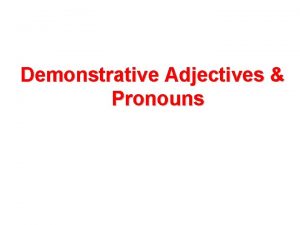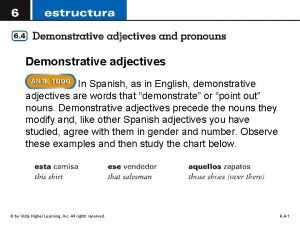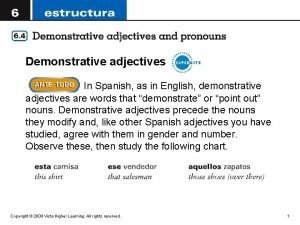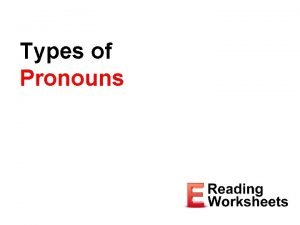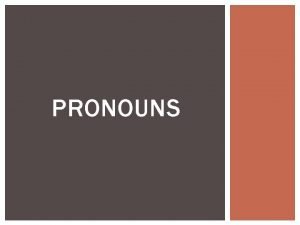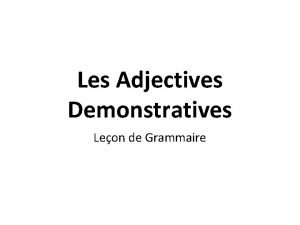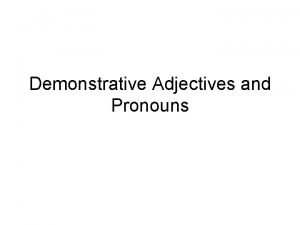Demonstrative adjectives In Spanish as in English demonstrative










- Slides: 10

Demonstrative adjectives In Spanish, as in English, demonstrative adjectives are words that “demonstrate” or “point out” nouns. Demonstrative adjectives precede the nouns they modify and, like other Spanish adjectives you have studied, agree with them in gender and number. Observe these examples and then study the chart below. Copyright © 2012 Vista Higher Learning. All rights reserved. 6. 4 -1

Copyright © 2012 Vista Higher Learning. All rights reserved. 6. 4 -2

u There are three sets of demonstrative adjectives. To determine which one to use, you must establish the relationship between the speaker and the noun(s) being pointed out. Copyright © 2012 Vista Higher Learning. All rights reserved. 6. 4 -3

u The demonstrative adjectives este, esta, estos, and estas are used to point out nouns that are close to the speaker and the listener. Copyright © 2012 Vista Higher Learning. All rights reserved. 6. 4 -4

u The demonstrative adjectives ese, esa, esos, and esas are used to point out nouns that are not close in space and time to the speaker. They may, however, be close to the listener. Copyright © 2012 Vista Higher Learning. All rights reserved. 6. 4 -5

u The demonstrative adjectives aquel, aquella, aquellos, and aquellas are used to point out nouns that are far away from the speaker and the listener. Copyright © 2012 Vista Higher Learning. All rights reserved. 6. 4 -6

Demonstrative pronouns u Demonstrative pronouns are identical to their corresponding demonstrative adjectives, with the exception that they traditionally carry an accent mark on the stressed vowel. The Real Academia now requires this accent only for clarification but it is still commonly used. Copyright © 2012 Vista Higher Learning. All rights reserved. 6. 4 -7

Copyright © 2012 Vista Higher Learning. All rights reserved. 6. 4 -8

u ¡Atención! Like demonstrative adjectives, demonstrative pronouns agree in gender and number with the corresponding noun. Copyright © 2012 Vista Higher Learning. All rights reserved. 6. 4 -9

u There are three neuter demonstrative pronouns: esto, eso, and aquello. These forms refer to unidentified or unspecified nouns, situations, ideas, and concepts. They do not change in gender or number and never carry an accent mark. Copyright © 2012 Vista Higher Learning. All rights reserved. 6. 4 -10
 Demonstrative adjectives and pronouns spanish
Demonstrative adjectives and pronouns spanish Spanish demonstrative adjectives
Spanish demonstrative adjectives Aquel aquella aquellos aquellas
Aquel aquella aquellos aquellas Demonstrative adjectives spanish
Demonstrative adjectives spanish Seven types of pronoun
Seven types of pronoun ... is dreaming (george)
... is dreaming (george) What is a demonstrative adjective
What is a demonstrative adjective Interrogative and indefinite pronouns
Interrogative and indefinite pronouns Demonstrative pronouns and interrogative pronouns
Demonstrative pronouns and interrogative pronouns Adjectives demonstrative in french
Adjectives demonstrative in french Demonstrative definition
Demonstrative definition
